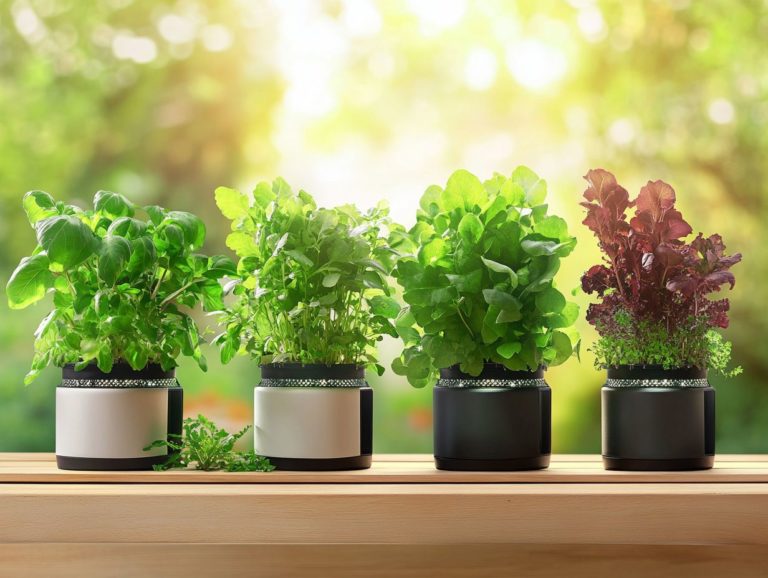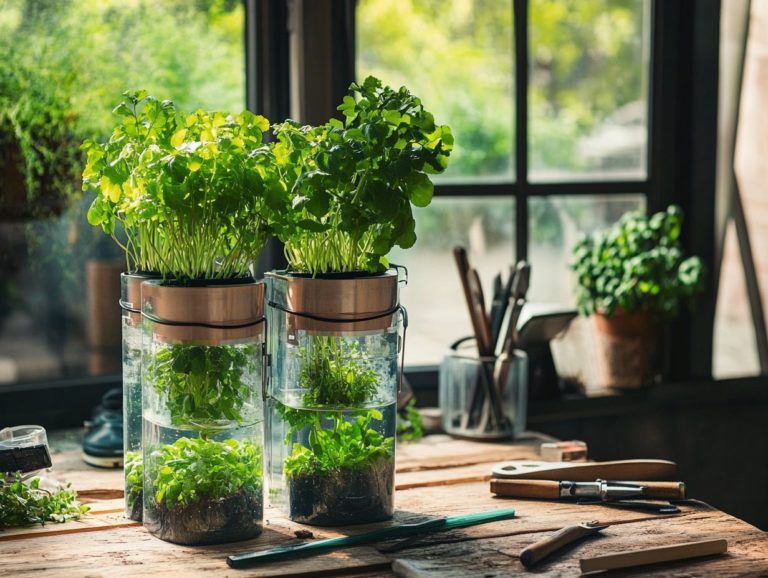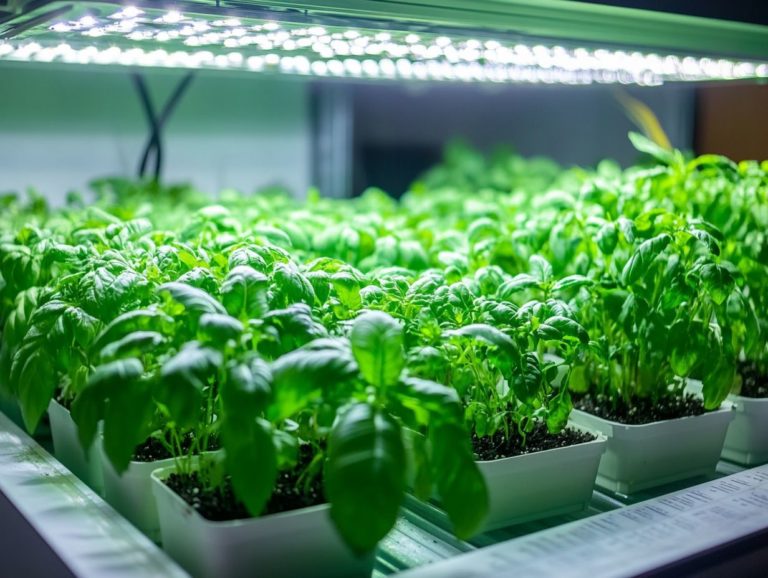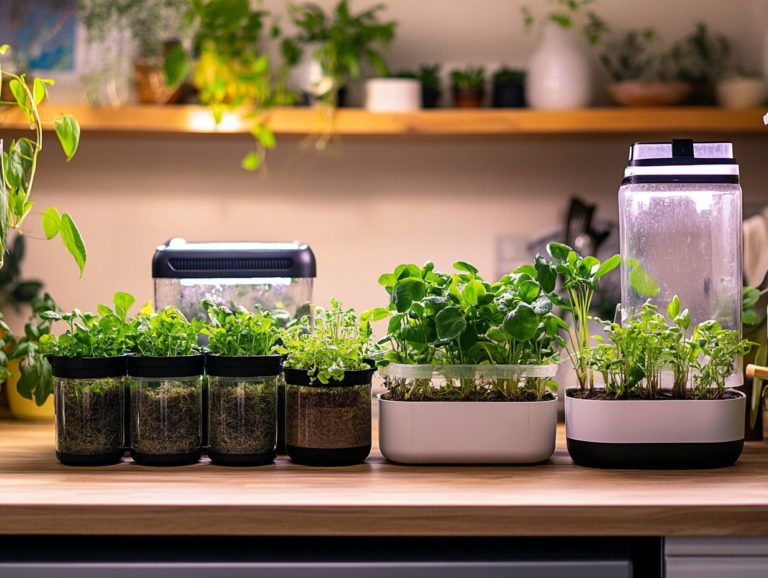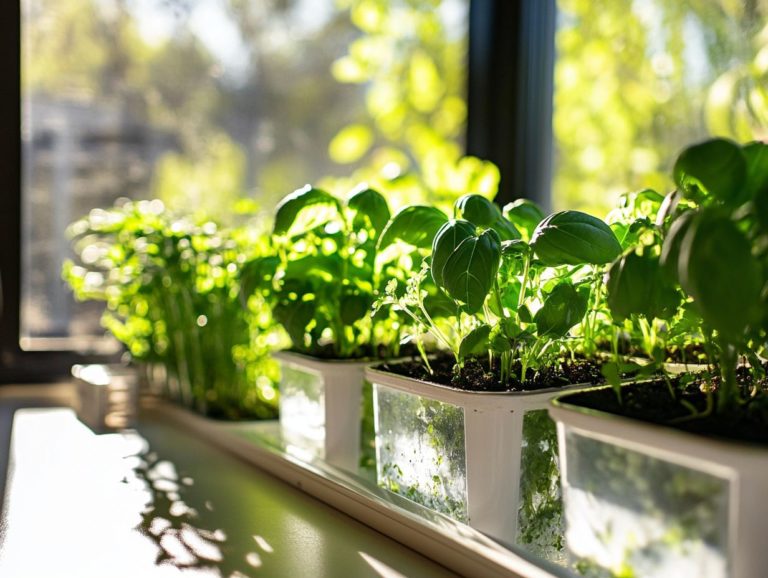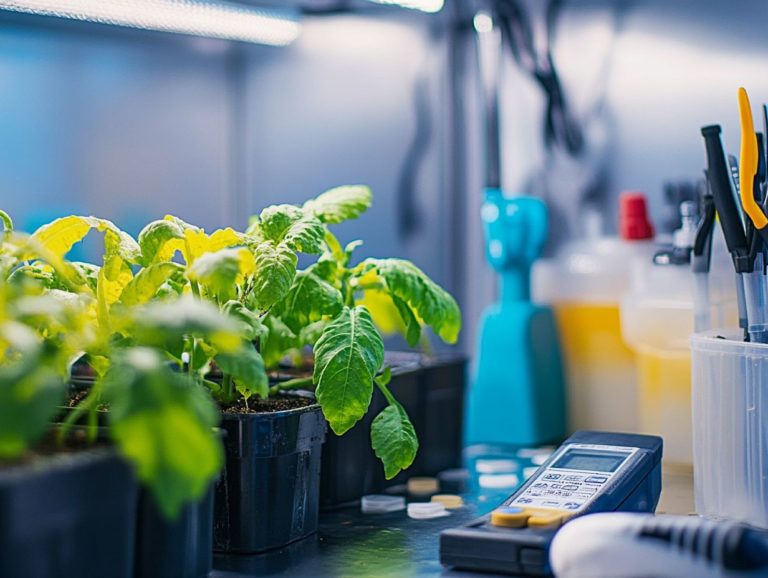DIY Hydroponic System Plans for Beginners
Hydroponics is revolutionizing your approach to gardening. By cultivating plants in a soil-less environment, this method optimizes space and resources. It s an attractive choice for urban dwellers and gardening aficionados alike. Get ready to grow a thriving garden at home!
This guide will walk you through the essentials of constructing your own hydroponic system, detailing its benefits, basic components, and specific setups such as drip systems and Deep Water Culture (DWC), a method where plants’ roots are submerged in nutrient-rich water.
Contents
- Key Takeaways:
- 2. Benefits of Building Your Own Hydroponic System
- 3. Basic Components of a Hydroponic System
- 4. Choosing the Right Plants for Your Hydroponic System
- 5. Types of Hydroponic Systems
- 6. Building a Simple Drip System
- 7. Constructing a Deep Water Culture System
- 8. Creating a Nutrient Film Technique System
- 9. Setting Up an Ebb and Flow System
- 10. Tips for Maintaining Your Hydroponic System
- 11. Troubleshooting Common Issues
- 12. Expanding Your Hydroponic System
- 13. Cost Comparison with Traditional Gardening
- 14. Frequently Asked Questions
- Frequently Asked Questions
- What is a DIY hydroponic system and why should beginners consider building one?
- What materials do I need to build a DIY hydroponic system?
- Are there different types of DIY hydroponic systems? Which one is best for beginners?
- Do I need any special skills or knowledge to build a DIY hydroponic system?
- How much space do I need for a DIY hydroponic system?
- Can I grow any type of plant in a DIY hydroponic system?
Key Takeaways:
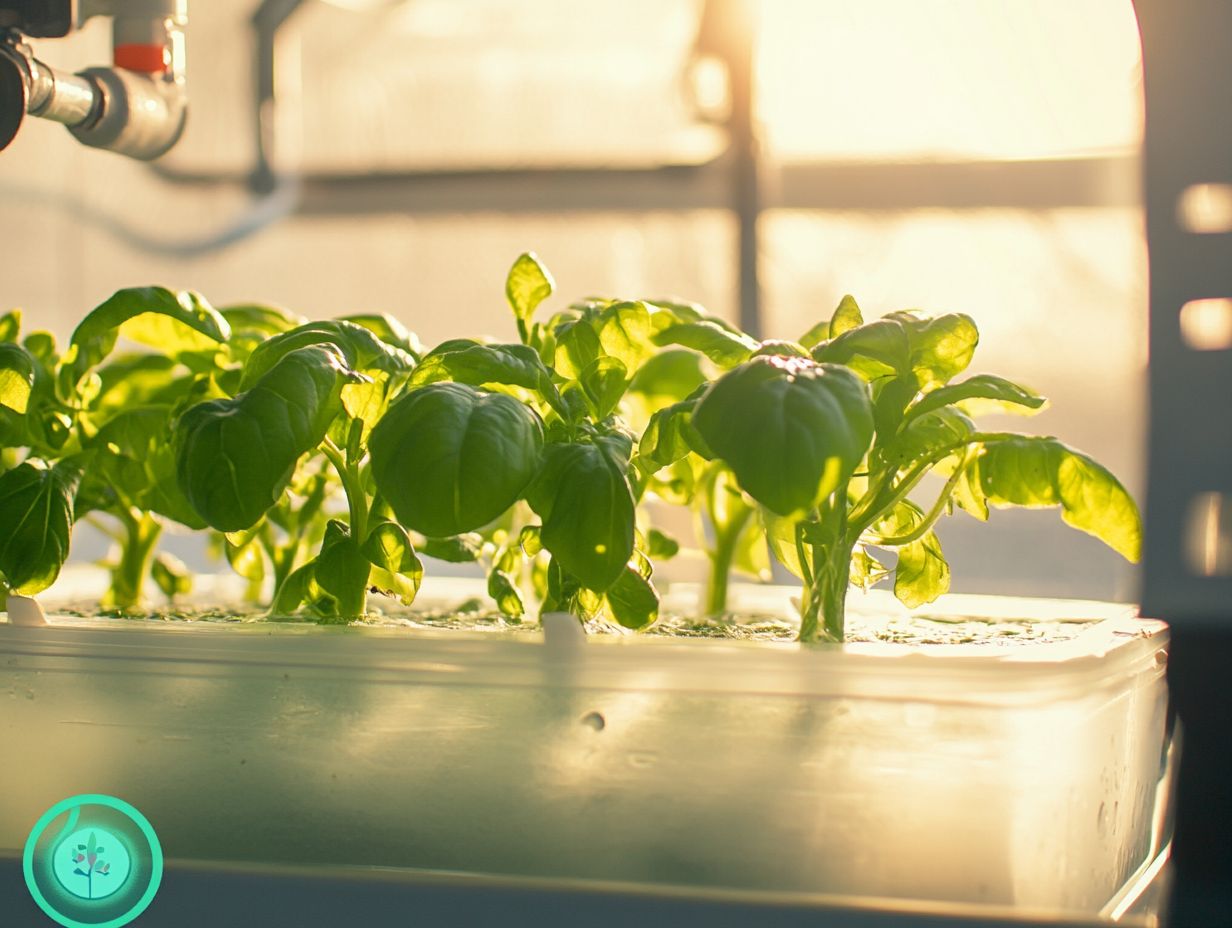
- Building your own hydroponic system is a cost-effective and sustainable way to grow fast-growing plants indoors.
- With the right components and proper maintenance, a DIY hydroponic system can produce higher yields and healthier plants compared to traditional gardening methods.
- There are various types of hydroponic systems to choose from, so beginners can start with a simple setup and expand as their skills grow.
2. Benefits of Building Your Own Hydroponic System
Building your own hydroponic system offers numerous advantages. Imagine growing fresh greens and vegetables right at home, eliminating the need to buy salad from the store and enjoying produce free from pesticides and chemicals.
This self-sufficiency allows you to grow fast-growing plants and customize nutrient solutions to match your tastes, enhancing both the flavor and nutritional value of your harvest.
The cost savings you’ll accumulate over time can be substantial, especially since buying organic produce in urban areas can quickly become expensive. By growing crops like lettuce, tomatoes, and herbs in your hydroponic setup, you can savor fresher, more flavorful options while benefiting from nutrient-rich produce.
This also promotes a sustainable lifestyle. The joy and satisfaction of nurturing plants to thrive can be incredibly rewarding. Plus, having a home garden means you always have fresh ingredients at your fingertips for quick, healthy meals, fostering better eating habits and overall well-being.
3. Basic Components of a Hydroponic System
A basic hydroponic system includes essential components like a water reservoir, plant cups, net pots, and growth mediums such as Rockwool and clay pebbles. Each component is vital for nurturing your plants. Ensuring the right pH levels the acidity or alkalinity of the water and providing adequate nutrients are crucial for your plants’ health, setting the stage for optimal growth and impressive yields.
Think of the water reservoir as the lifeblood of your system, delivering a carefully balanced nutrient solution straight to the roots absolutely essential for robust plant development. The plant cups and net pots offer structural support, allowing roots to expand freely while ensuring proper aeration and drainage. This helps prevent harmful waterlogged conditions.
Choosing the right growing medium is just as important. Materials like Rockwool retain moisture while promoting excellent airflow, whereas clay pebbles excel at drainage and root stability. Maintaining a balanced nutrient mix guarantees that your plants receive the vital vitamins and minerals they need for vigorous growth and resilience against pesky pests.
Start building your hydroponic system now and enjoy fresh produce in no time!
4. Choosing the Right Plants for Your Hydroponic System
Selecting the right plants for your hydroponic system is essential for your success, especially when growing indoors, where factors like light, temperature, and nutrient availability can fluctuate significantly.
Consider popular choices like cutting plants, vegetables, herbs, and microgreens, each with its own unique requirements and growth patterns that thrive in a hydroponic environment.
To cultivate a flourishing garden, you must account for factors such as growth rate, space requirements, and compatibility with hydroponic techniques. For example, lettuce and basil are excellent options for beginners. Their rapid growth and minimal space needs make them perfect for smaller setups.
On the other hand, if you re a more experienced grower, you might venture into cultivating tomatoes or peppers. These plants require a bit more attention, but the rewarding results make the effort worthwhile.
Don t overlook additional considerations like light duration and nutrient levels. These factors will enhance plant compatibility and contribute to the overall success of your system.
5. Types of Hydroponic Systems
You ll also find a variety of hydroponic systems at your disposal, such as Deep Water Culture (DWC), Ebb and Flow systems, and Nutrient Film Technique. Each offers a unique approach to cultivating plants without soil, and understanding the distinctions among them is crucial for selecting the perfect option tailored to your specific needs and growing conditions.
Deep Water Culture (DWC) stands out for its simplicity. It allows your plants to float in a nutrient-rich solution, encouraging rapid growth by providing constant access to nutrients and oxygen. However, be mindful of temperature fluctuations; this system may not perform well in extreme climates.
Ebb and Flow systems take a different approach, periodically flooding the grow bed with nutrient solution before draining it back into the reservoir. This method promotes aeration and is adaptable for various plant types, though it requires a more intricate setup and precise timing to get just right.
The Nutrient Film Technique continuously flows a thin layer of nutrient solution over the roots, helping with excellent aeration and nutrient uptake. This system is ideal for fast-growing crops but demands careful management of nutrient levels, making it best suited for those with more experience.
Visual aids will boost your understanding of how each system operates, particularly when building a system from scratch.
6. Building a Simple Drip System
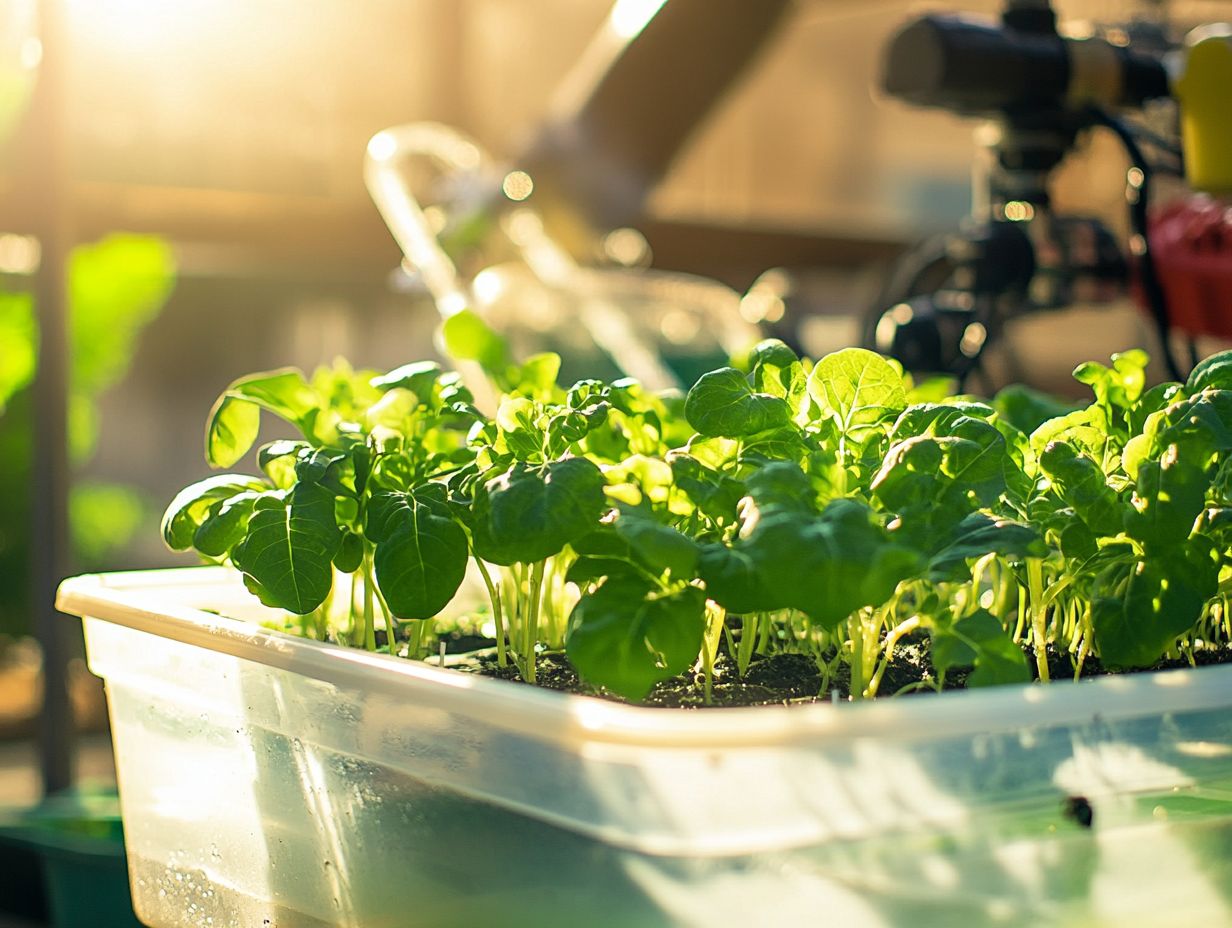
Building a simple drip system can kickstart your hydroponic adventure! It requires just a few basic tools and materials.
Here s what you ll need:
- Tools required: drill, scissors, tape measure
- Materials required: water pump, timer, connectors, drip tubing, net pots filled with suitable growing mediums
First, choose a location with ample sunlight or fluorescent grow lights. Position your water reservoir at an optimal height to ensure smooth water flow using gravity throughout the system.
After installing the drip tubing, keep a close eye on your plants to fine-tune the water flow according to their specific needs. Regularly monitoring pH and nutrient levels will significantly enhance your plants’ growth, ensuring they receive the perfect balance of hydration and nourishment.
By following these steps, you can easily establish your own productive drip irrigation system and enjoy the fruits of your labor, making you a more self-sufficient home grower.
7. Constructing a Deep Water Culture System
Constructing a Deep Water Culture (DWC) system is an exceptional way for you to cultivate plants in a nutrient-rich water environment. By incorporating a water pump and an air pump, you can maintain optimal oxygen levels and circulation.
Utilizing a storage container as the reservoir and net pots to support your plants allows you to create a highly productive hydroponic setup. This setup is all about key components! Let s dive in!
First, choose a storage container that s typically dark or opaque; this minimizes algae growth while holding your nutrient solution. The water pump does the heavy lifting by circulating the liquid, ensuring that nutrients are evenly distributed. The air pump introduces vital oxygen through an air stone, which is important for promoting healthy roots.
Opt for nutrient solutions specifically designed for hydroponics, as they provide the essential elements your plants need for growth. Managing oxygenation and nutrient levels is especially important. Optimal conditions can lead to remarkable plant growth and overall vitality, ensuring that your plants flourish in this meticulously controlled environment.
8. Creating a Nutrient Film Technique System
The Nutrient Film Technique (NFT) is an important hydroponic system that allows you to provide plants with a thin film of nutrient-rich water flowing over their roots. This method ensures they receive essential nutrients while enjoying optimal oxygenation.
To set up your NFT system, start by designing a layout featuring a sloped channel where the nutrient solution can flow freely. You’ll need key materials such as a reservoir, a pump, lightweight growing trays, and net pots to securely hold your plants.
Maintenance is paramount; regularly check the pH and EC levels (Electrical Conductivity) of the nutrient solution to keep them within optimal ranges.
One of the standout benefits of adopting this technique is the remarkable reduction in water usage compared to traditional farming methods. You can efficiently grow a diverse array of plants, from leafy greens to herbs, maximizing both space and yield in your setup!
9. Setting Up an Ebb and Flow System
Setting up an Ebb and Flow system, often referred to as a flood and drain system, involves periodically flooding your grow bed with a nutrient solution from a water reservoir using a submersible pump. Let it drain back to ensure your plant roots receive both water and oxygen, fostering healthy growth!
To create an efficient Ebb and Flow system, you’ll need to gather a few essential components:
- A sturdy grow bed to support the plant medium.
- A submersible pump, crucial for moving nutrient-rich water to the grow bed, paired with a timer to regulate the flooding and draining cycles.
- An effective drainage system to facilitate the return of excess water to the reservoir.
Best practices recommend timing your cycles to flood the grow bed for about 15-30 minutes every 1-2 hours, tailored to your plants needs and environmental conditions. This meticulous timing helps maintain optimum moisture levels without suffocating the roots, boosting the overall health and yield of your plants!
10. Tips for Maintaining Your Hydroponic System
Proper maintenance is crucial for the success of your hydroponic system, emphasizing key factors like water quality, plant nutrients, and pH levels to ensure your plants flourish. By regularly monitoring these elements, you can troubleshoot issues before they escalate, fostering a healthy growing environment.
- Check the water quality at least once a week, ensuring it’s free from contaminants and adequately oxygenated.
- Evaluate nutrient levels every two weeks to make timely adjustments that can significantly boost growth.
- Pay close attention to pH levels, maintaining them between 5.5 and 6.5. Testing these every few days can help avert potential issues.
- Regularly clean the system, flush the reservoir, and sanitize the grow trays to eliminate harmful bacteria buildup.
- Address common issues like nutrient deficiencies or pH fluctuations to sustain optimal plant growth.
For those interested in expanding their gardening techniques, check out this guide on how to build a simple hydroponic system. Stay proactive and watch your plants thrive!
11. Troubleshooting Common Issues
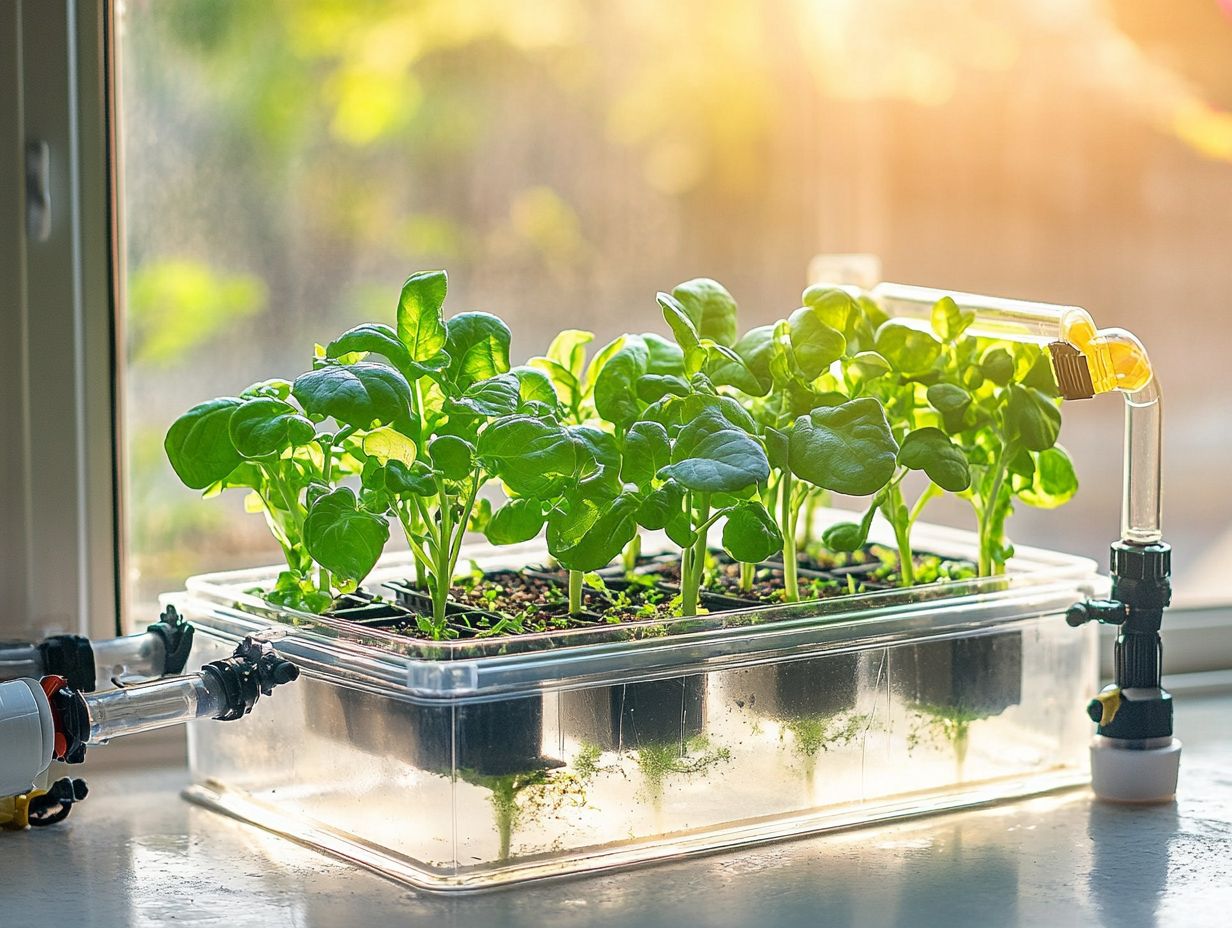
Troubleshooting common issues in your hydroponic system is essential for maintaining plant health and achieving successful yields. Problems can stem from factors such as nutrient imbalances, pests, or equipment malfunctions. Identifying these issues early allows you to implement quick resolutions and promote sustained growth.
Nutrient deficiencies often present as yellowing leaves or stunted growth, typically due to an unbalanced nutrient solution. Regularly monitor and adjust your nutrient levels to combat this.
While pests are less common in hydroponics compared to traditional gardening, they can still pose a threat. Using smart measures like beneficial insects or organic pesticides can help you fight pests effectively.
Ensure your water quality is at the right pH and electrical conductivity (EC) levels to prevent various issues. Regularly inspecting your equipment helps avert costly system failures, keeping your plants thriving and productive.
12. Expanding Your Hydroponic System
Expanding your hydroponic system opens up incredible opportunities for boosting your crop yield and allows you to experiment with new techniques and plant varieties. To successfully scale up, evaluate the tools and materials necessary for constructing hydroponics that can accommodate larger or more diverse plant populations.
Consider additional growing areas, such as vertical setups or more expansive greenhouse spaces, to maximize light exposure and optimize resource use.
Diversifying your plant types enriches your garden s output and acts as a safeguard against pests and diseases, effectively spreading out risk. Adopting advanced hydroponic systems can further improve water efficiency and nutrient management.
Keep in mind that these enhancements require meticulous planning. An increase in space directly correlates with higher resource demands and potentially escalated maintenance needs. Efficiency in your planning, resource allocation, and workflow organization becomes paramount to ensuring sustainable growth.
13. Cost Comparison with Traditional Gardening
When you compare the costs of hydroponic systems to traditional gardening methods, it s crucial to weigh both the initial investment and the long-term savings that come with growing your own food. Setting up a hydroponic system might hit your wallet a bit harder at first, but the efficiency, space-saving benefits, and rapid growth can lead to considerable savings down the line.
Investing in specialized equipment like grow lights, pumps, and nutrient solutions can add up, but don t let that deter you. These upfront costs are often balanced out by lower maintenance expenses and the higher yields that hydroponics provides, allowing for a continuous harvest all year round.
On the flip side, traditional gardening may seem like the budget-friendly option initially but often faces hurdles such as seasonal constraints and unpredictable pests, which can ramp up costs over time. Embracing hydroponic methods grants you access to fresher produce, no matter the weather, and can help lower your food expenses.
By tapping into these efficient systems, you can enjoy a consistent supply of healthy ingredients, leading to both financial savings and enhanced nutrition.
Start your hydroponic journey today and see the difference!
14. Frequently Asked Questions
Frequently asked questions about hydroponics typically focus on the essentials of setup, plant care, and troubleshooting common issues. These insights are valuable for both novices and seasoned home growers.
By addressing these queries, you can pave a smoother path into the realm of DIY hydroponics. This will help you cultivate a deeper understanding of the system.
You may find yourself exploring the various types of hydroponic systems, such as deep water culture or a method that uses a thin film of nutrient-rich water to feed the plants. For beginners, checking out the top hydroponic growing systems can be particularly helpful. Considering which plants will thrive in these unique environments will surely ignite your curiosity.
Many also wonder how to effectively manage nutrient levels and maintain pH balance for optimal growth. Practical maintenance tips are invaluable, guiding you on how to ward off disease and maximize your yields sustainably.
By diving into these common inquiries, you can truly enhance your hydroponic gardening experience, leading to fruitful cultivation and bountiful harvests.
Frequently Asked Questions
What is a DIY hydroponic system and why should beginners consider building one?
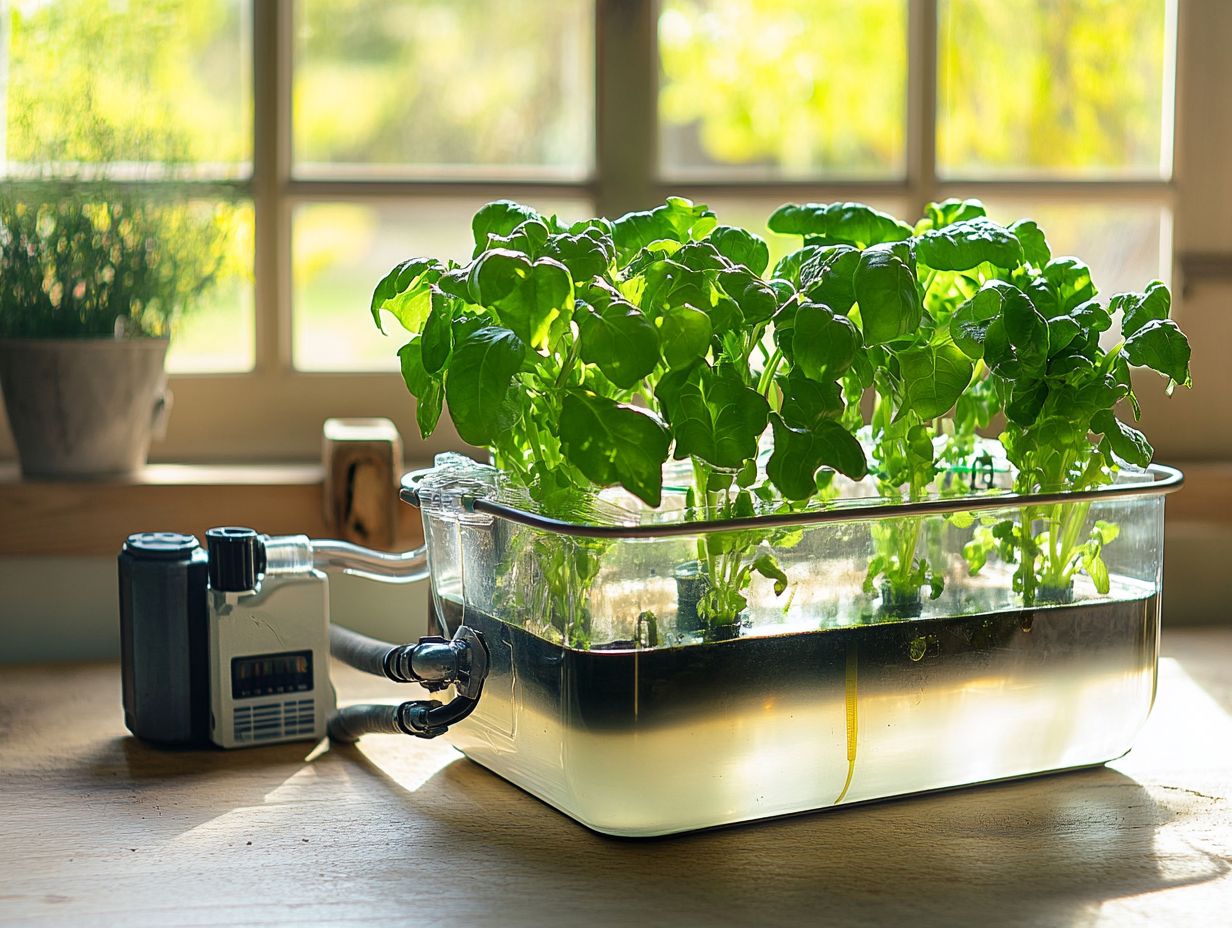
A DIY hydroponic system is a method of growing plants without soil, using nutrient-rich water instead. It s an exciting way for beginners to dive into gardening!
What materials do I need to build a DIY hydroponic system?
The materials needed will depend on the type of hydroponic system you choose to build. Common items include:
- A container
- Growing medium
- Nutrient solution
- A pump
- Lighting
You may also need tools such as a drill or scissors for construction.
Are there different types of DIY hydroponic systems? Which one is best for beginners?
Yes, there are several types of DIY hydroponic systems, including deep water culture, drip irrigation, and ebb and flow. For beginners, it is recommended to start with a simple system like deep water culture, as it requires less maintenance and is easier to set up.
Do I need any special skills or knowledge to build a DIY hydroponic system?
No, you do not need any special skills or knowledge to build a basic DIY hydroponic system. There are many tutorials and guides available online. Most systems can be built using simple household items.
However, it is important to understand the basics of hydroponic gardening and how to maintain your system for the best results.
How much space do I need for a DIY hydroponic system?
The amount of space needed will depend on the size of your system and the plants you want to grow. For a small, beginner system, you can use a container as small as a 5-gallon bucket.
Larger systems may require more space and can be built outdoors or in a dedicated indoor area.
Can I grow any type of plant in a DIY hydroponic system?
While most plants can be grown in a hydroponic system, some may be more difficult for beginners to grow. Leafy greens, herbs, and smaller vegetables like tomatoes and peppers are popular choices for DIY hydroponic gardening.
It is best to do some research on the specific needs of the plants you want to grow before starting your system.

